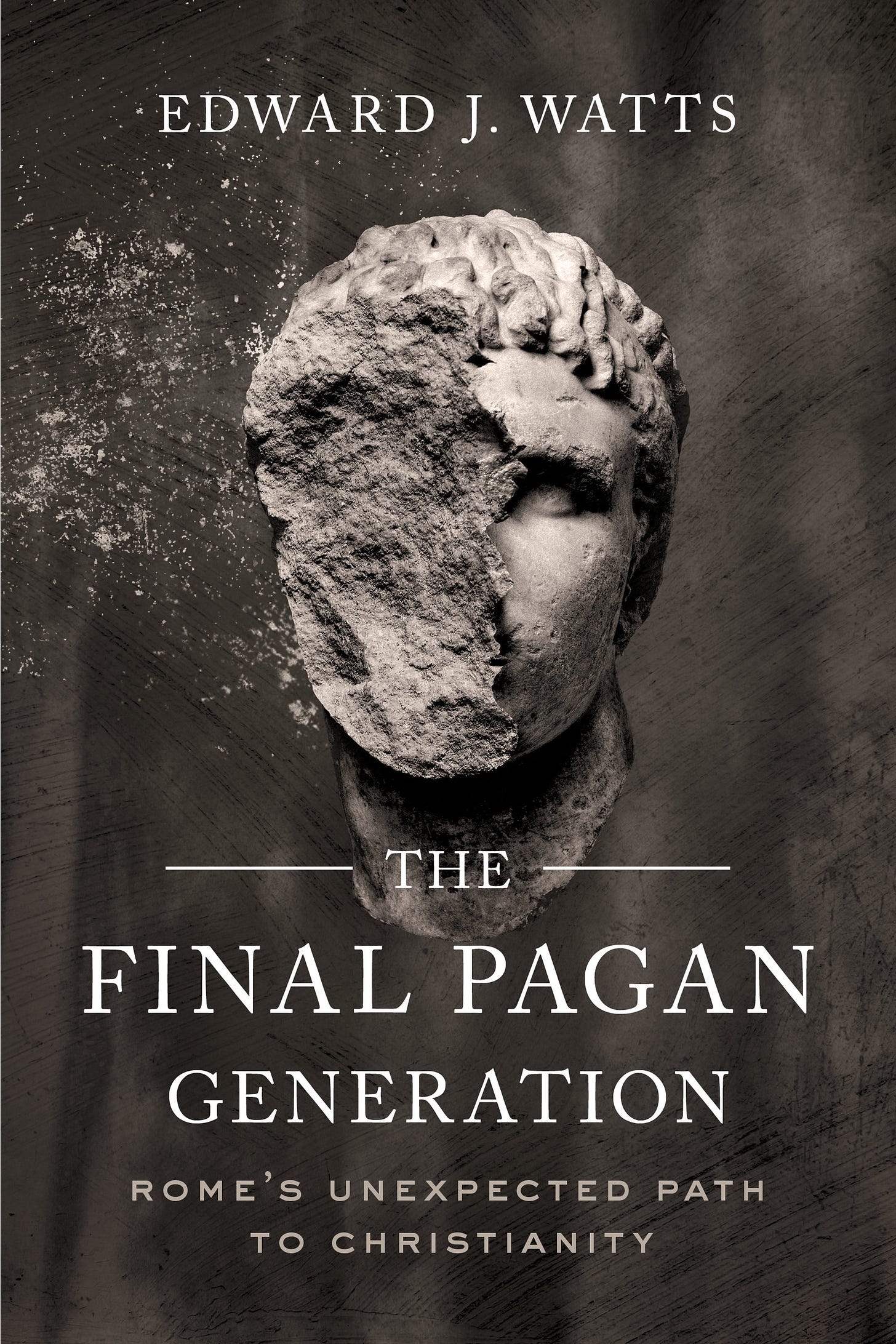FbF Book Club: The Final Pagan Generation (Watts, 2015)
Introduction and Chapter 1
(Please consider sharing this on social media as I cannot do so at present. Thank you kindly.)
My present apartment sits roughly 150 feet away from the Golden Gate, the northern entry into Emperor Diocletian’s Palace here in Split. I walk through the Palace every single day, and consider myself incredibly lucky that I get to this. You can’t help but feel inspired by what Diocletian had built for himself in order to enjoy his retirement.
Towards the centre of Palace one will find the Cathedral of Saint Domnius. It is a very unique structure in that it incorporates pillars that belonged to the mausoleum that housed Emperor Diocletian’s remains. St. Domnius (from Antioch) was the Bishop of nearby Salona, the largest city in Roman Dalmatia, and purportedly the birthplace of Diocletian himself. Domnius was martyred along with seven other Christians by Diocletian, who would go on to become the last great persecutor of Christians in the Roman Empire.
A mausoleum implies a crypt, and a crypt implies remains, whether a corpse or a skeleton. I don’t know why I hadn’t asked before, but roughly five or six years ago I took a few friends from the USA and Australia down into the crypt and asked the employee: “Is Diocletian’s body in there?” “No”, she replied. “The early Christians threw it into the sea. They were kinda like what ISIS is today.”
I should have figured this out myself.
This brings us to “The Final Pagan Generation”, by Edward J. Watts. Completed in 2013 and published two years later, this book has received high praise in many locations and has been on my “must put down the laptop and actually read it” list, one that is already far too long. This book takes a chronological look at the bulk of 4th century Rome, both the Eastern and Western halves, by focusing on what he calls “the last pagan generation”. This is the generation born around AD 310, just before Constantine converted to Christianity. Watts equates this cohort with today’s Generation X, of which both he and I are members; a generation overshadowed by the one that came before it and the one that arrived just after it. He goes further and describes it as the then “silent majority”. This doesn’t mean that all those of this generation were actual Pagans, as many were themselves already Christians, including several of whom he relies on as sources for material in this work.
This is the generation that was brought up in Pagan Rome, one in which paganism of the Roman kind was already 1,000 years old. In short, a permanent feature. By the end of their lives, that permanence was almost completely gone. Through focusing on how the elites navigated the decades, Watts intends to show us how this massive shift from paganism to Christianity took place, how people reacted to it, and just as importantly, how people didn’t react to it, and the various reasons why they didn’t do so.
I brought up the desecration of Diocletian’s remains because Watts opens the book up with the story of the Sack of the Serapeum by the Christians of Alexandria in AD 392. The Serapeum was a very large temple in Alexandria, sitting on the most prominent piece of real estate in that city that was estimated to house half a million people at the time. Honouring the god Serapis, it was the location to which rioting Pagans fled after engaging in street battles with Christians due to Bishop Theophilus’ mocking of Pagan religious artifacts uncovered during construction work at a nearby basilica.
The temple was too strong of a fortification for the Christians to storm, and a deadlock ensued. A letter from the Emperor promised pardons for the Pagans if they left the site, which they did. That’s when the fun started: Christians rushed to the temple, seized the massive statue of Serapis, broke it apart, and then took the various parts to different quarters of the city to burn in public.
Watts tells us that these rioting Pagans and Christians were young, the children of the generation that he has focused on in this history. This younger generation was much more radical than their parents, having grown up in a Rome that had already changed by way of Christians taking the place of Pagans as Emperors.
As Watts puts it:
The destruction of the Serapeum similarly capped a period of increasingly severe threats to the temples and synagogues of the Roman Empire’s traditional religious communities. In the 380s, emperors cut funding for traditional cults in Italy and denied an appeal to restore the Altar of Victory in the Roman senate house; administrators in the East attempted to cut the sacred grove at Daphne outside of Antioch and led a sustained campaign against rural shrines in Mesopotamia, Syria, and Egypt.10 The same social and religious trends that propelled these anti-pagan actions also led to the events at the Serapeum. This Alexandrian event, however, seems to have fundamentally changed many people’s awareness of the threat to traditional religious institutions. For the first time, pagans understood that Christian attacks could reach the most permanent and impressive elements of the urban religious infrastructure. Christians now saw temple destructions, both within and outside of cities, as a realistic way to remake the religious topography of the empire.




